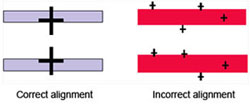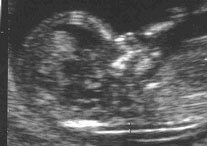Nuchal Translucency
This is a collection of fluid under the skin behind the neck of fetuses at 11-13+6 weeks that can be measured by ultrasound examination. In fetuses with chromosomal abnormalities, cardiac defects and many genetic syndromes nuchal translucency is increased.
If you want to learn more about nuchal translucency select the '11-13+6 Weeks Scan Book' link.
If you want to learn more about The Fetal Medicine Foundation certification process please select the Accreditation link.
Measurement of Nuchal Translucency
- The fetal crown-rump length should be between 45 and 84mm.
- A good sagittal section of the fetus must be obtained, with the fetus horizontal on the screen. The correct view is a clearly visualised fetal profile.
- The fetus should be in a neutral position, with the head in line with the spine, not hyper-extended or flexed.
- Ideally only the fetal head and upper thorax should be included. The magnification should be as large as possible and ALWAYS such that each slight movement of the callipers produces only a 0.1mm change in the measurement.
- The widest part of translucency must always be measured.
- Measurements should be taken with the inner border of the horizontal line of the callipers placed ON the line that defines the nuchal translucency thickness - the crossbar of the calliper should be such that it is hardly visible as it merges with the white line of the border, not in the nuchal fluid. However, when tissue harmonic imaging (THI) is used the calipers should be placed slightly inside the NT lines rather than on the lines as THI might thicken the lines.
- In magnifying the image (pre or post freeze zoom) it is important to turn the gain down. This avoids the mistake of placing the calliper on the fuzzy edge of the line which causes an underestimate of the nuchal measurement.
- Care must be taken to distinguish between fetal skin and amnion.
- During the scan more than one measurement must be taken and the maximum one that meets all the above criteria should be recorded in the database. It is good practice to retain at least one image for your patient records.




